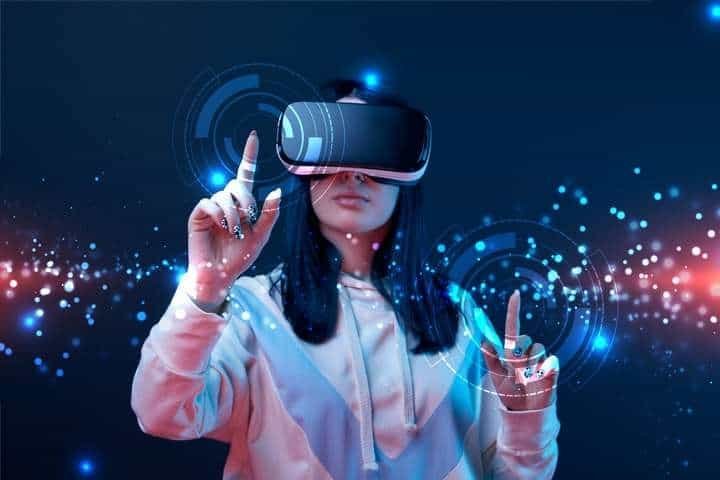How Virtual Reality Is Transforming the Entertainment Industry

Virtual reality is transforming the entertainment industry, creating immersive and interactive experiences that are changing how we consume and engage with media. Imagine stepping into a fantastical world, witnessing a historical event firsthand, or experiencing a movie scene in unprecedented detail. Virtual reality (VR) is bringing these fantasies to life, impacting industries from gaming and filmmaking to education and training. This article will explore the profound impact of VR on entertainment, examining its impact on gaming, film, and interactive storytelling, along with potential challenges and future opportunities. We’ll also investigate how VR is revolutionizing education and training through immersive experiences. The structure of this article includes sections on VR’s impact on gaming, film, and education. The article then closes with a summary of the key takeaways and a look into the future of VR in entertainment.
1. Transforming Gaming with Immersive Worlds
1.1 VR Gaming's Exponential Growth
Virtual reality has ignited a revolution in gaming, taking players to entirely new dimensions of engagement. Immersive environments and interactive controls create unprecedented opportunities for gameplay and narrative immersion, attracting new audiences and fostering a sense of presence and realism. This heightened sense of engagement has dramatically increased user participation and has attracted both hardcore and casual gamers. Recent statistics from market research show significant growth in virtual reality gaming revenue, signaling the industry’s ongoing development and potential.
1.2 Beyond the Screen: Experiential Gaming
VR gaming transcends the traditional 2D screen experience by creating a sense of presence that was previously unimaginable in video games. In virtual reality, players are no longer passive observers but active participants in the game’s narrative. Interactive controls and responsive environments allow for unprecedented freedom of movement and interaction, pushing the boundaries of gaming entertainment and creating more immersive and interactive gameplay. Examples of successful VR games include [insert 2-3 examples of successful VR games and platforms].
1.3 The Future of Virtual Reality Gaming
The future of virtual reality gaming looks bright, with projections for continued growth and innovation in the coming years. The development of more advanced VR hardware and software will likely bring enhanced immersion, allowing for more sophisticated and complex gaming environments. The ongoing integration of artificial intelligence will likely personalize player experiences and elevate gaming to new heights.
2. Immersive Storytelling: Redefining Film and Interactive Media
2.1 From Screen to Experience: Immersive Filmmaking
The use of virtual reality in filmmaking has brought the cinematic experience to a new level of realism and interactivity. With VR, viewers are no longer confined to a passive viewing experience but can actively participate in the narrative, moving through scenes and interacting with characters in ways never before imagined. Early adopters of VR are reporting a massive increase in audience engagement. This immersive experience is allowing for greater emotional connection with the story, which in turn is bolstering audience appreciation and understanding.
Related Post : How Biotech Is Pushing the Boundaries of Medicine and Healthcare
2.2 Interactive Experiences: VR's Impact on Film
The rise of virtual reality has spurred the development of interactive films, offering viewers unprecedented control over their cinematic journey. Storylines are branching out to allow for multiple paths based on the viewer’s actions, choices, and decisions. These choices create unique and individualized experiences, moving away from the traditional cinematic experience. Examples of this include interactive films where the audience can influence the plot by making choices throughout the narrative.
2.3 A New Era for Interactive Entertainment
With continued innovation, VR storytelling is poised to revolutionize the entertainment industry, transforming the way we experience movies, games, and other forms of media. The merging of film and VR technologies offers exciting opportunities for creative storytelling and audience engagement, promising to create immersive and interactive experiences for years to come.
3. Revolutionizing Education and Training
3.1 Transforming Learning Experiences: VR in Education
Virtual reality is transforming education by providing immersive and interactive learning experiences that help learners better grasp abstract concepts, improve their knowledge retention, and motivate a greater interest in the subject. By immersing students in virtual environments, educators are able to create memorable and interactive lessons that promote engagement and motivation in learning. There are numerous examples of educational institutions using VR to complement traditional teaching methods.
3.2 Improving Skills through Practice and Simulation
VR provides a safe and controlled environment for professionals to practice complex skills and procedures in real-life scenarios without real-world risks or consequences. This allows for valuable experience and better preparation for professional endeavors. Virtual reality training is becoming increasingly popular in a variety of industries, including healthcare, aviation, and engineering.
3.3 The Future of VR in Education and Training
As VR technology continues to evolve, it is expected to play an even greater role in shaping future learning and skill-building methods. Future applications could include simulated work environments, virtual field trips, and personalized learning experiences tailored to individual needs and preferences, revolutionizing the way we learn and train.
4. Addressing Challenges and Concerns
4.1 Cost and Accessibility of VR Technology
The high initial cost of VR headsets and equipment, including VR software and high-quality content creation tools, remains a significant barrier for many individuals and organizations, hindering wider adoption. However, there’s increased affordability as technology continues to advance and new entrants enter the marketplace.
4.2 Maintaining Immersive Engagement and Comfort
Sustaining prolonged immersion in virtual reality can sometimes pose challenges related to user comfort and potential motion sickness, which can negatively affect the user experience. Researchers are constantly working on solutions to create more comfortable and immersive VR experiences.
4.3 The Importance of High-Quality Content
The effectiveness of VR experiences hinges on the quality and engaging nature of the content. The quality of the VR environment and the storytelling must be top-notch to fully engage audiences.
5. The Future of Virtual Reality Entertainment
5.1 Evolution of Technology and Content Creation
The ongoing evolution of VR technology and the development of advanced software applications are set to create more immersive, realistic, and interactive entertainment experiences. Expect to see a rise in creative content as the technology progresses. This will continue to impact the way we interact with media and technology.
5.2 VR's Impact on Businesses and the Entertainment Industry
The increasing popularity and accessibility of VR technology is prompting businesses to integrate VR into their operations, further driving the transformation of the entertainment sector. This evolution will likely bring new opportunities for businesses, entertainment companies, and individuals.
5.3 Further Applications and Innovations
The future of virtual reality promises diverse and exciting applications across various industries, pushing the boundaries of what is possible and opening doors to even more innovative and creative solutions to solve pressing problems.
Q2: How is virtual reality changing the gaming industry?
Ans: Virtual reality (VR) is significantly transforming the gaming industry by providing immersive gaming experiences and interactive gameplay. Gamers are no longer passive observers, but active participants in the narrative. Interactive controls and responsive environments provide unparalleled freedom of movement and interaction, which results in more engaging and interactive experiences.
Q3: What are the challenges associated with implementing virtual reality technologies?
Ans: One challenge associated with VR technology is the high initial cost of VR equipment and software. Maintaining immersive engagement and minimizing discomfort, such as motion sickness, also poses a significant concern. Lastly, generating high-quality content that maintains user interest remains a priority in this rapidly evolving technology.
Q4: What are the long-term prospects for the use of virtual reality in entertainment?
Ans: The long-term prospects for virtual reality in entertainment are very promising, with projections for continued growth and innovation. Advancements in VR technology and content creation will provide even more immersive and realistic experiences. The increasing accessibility of VR and associated technologies will drive its continued use across diverse sectors. As technology continues to evolve, so will virtual reality applications in the entertainment industry.
In conclusion, virtual reality is revolutionizing the entertainment industry, creating immersive experiences that captivate audiences and drive innovation. From gaming and film to education and training, VR is poised to reshape how we interact with and consume entertainment. To fully leverage the potential of VR, businesses need to invest in high-quality VR technologies and develop engaging content. Explore VR opportunities today, and be part of this exciting transformation! Learn more about the future of entertainment at [your website address].
Share this content:














Post Comment